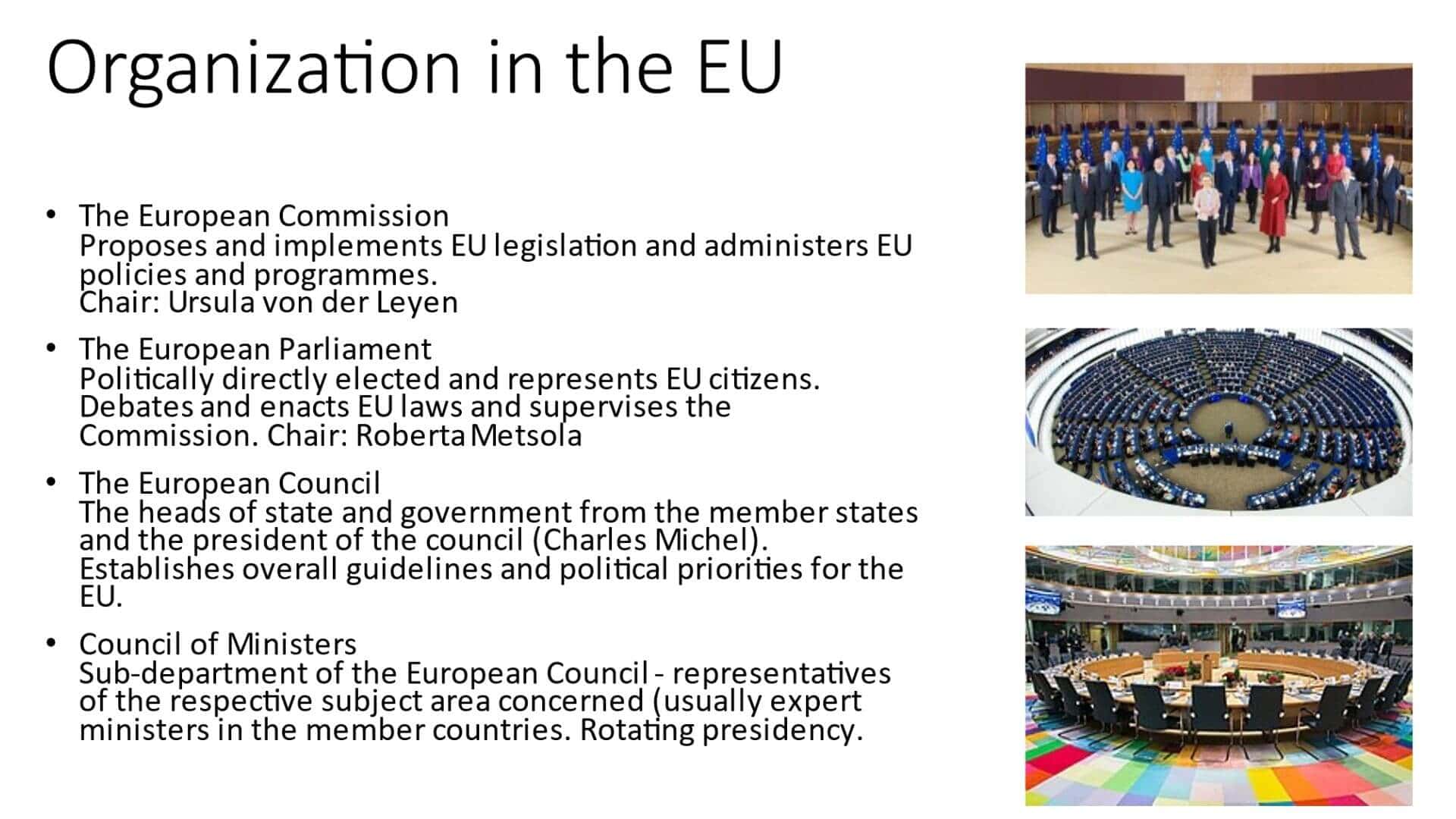EU directive on energy use in buildings – What’s going on?
The European Union has strong ambitions in terms of sustainability and climate adaptation. Overall, this is formulated in the EU’s climate law from 2021. The law establishes the Union’s goal for Europe’s economy and society to become climate-neutral by the year 2050. In addition, the law sets a goal that the net emissions of greenhouse gases must be reduced by at least 55% by 2030, compared with 1990 levels. This goal goes within the EU under the name “Fit for 55”. Climate neutrality by 2050 means net zero emissions of greenhouse gases for the EU countries. This must be achieved by reducing emissions, investing in green technologies, and protecting nature. The measures must be socially fair and cost-effective. The law shall also promote predictability for investors in the built environment and other economic actors in the built environment sector.
Regulations and directives – the Union’s policy instruments
EU legislation consists of Regulations, which are binding and directly affect the member country’s legal system, and directives, which must be transposed and implemented into the member country’s legal system.
Two important directives within the EU, not least in the construction and property sector, are the EU Directive on the Energy Performance of Buildings (EPBD), first established in 2002 and last revised in 2018, and the EU Directive on the Energy Efficiency of Buildings (EED) which was decided in March 2023 and applied from September of the same year. The EED is more macro-political and deals with general requirements on the member states at a national level, while the EPDB has a more direct impact on construction and property stock in the member states.
The directive on the energy efficiency of buildings (EED) was established in its latest version in September 2023. The most important element of the directive is that the total energy use in the member countries must be reduced by 11.7% by 2030. The public sector is required to reduce its energy use annually by 1.9%.
The road towards a revised directive on the energy performance of buildings
The Energy Performance of Buildings Directive (EPDB) is currently (2023) undergoing extensive revision.
The main goals of the audit are that all new buildings must be zero-emission buildings by 2030 and that existing buildings must be remedied to zero-emission buildings by 2050.
The revision is under preparation within the EU, and it is not entirely clear today (autumn 2023) what all parts of the directive will look like in their established state. The procedure for a revision of an EU directive is that the revision is first discussed in the European Parliament, which agrees on a proposal for a revised directive. This proposal then goes on to a so-called trilogue negotiation between the Commission, the Council, and the Parliament, after which the result of the trilogue negotiation goes to the Council of Europe for discussion, modifications, and decisions, which all member states stand behind. For the directive to be finally established, it is considered in the parliament, and after a political agreement between the parliament and the council, the final text is adopted.
European Parliament proposal
According to the proposal voted for by the European Parliament in the spring of 2023, existing residential buildings, on a scale from A to G, where A corresponds to the best energy performance and G the worst, would achieve energy performance class E by 2030 and D by 2033. For existing commercial properties, energy performance class E was proposed by 2027 and D no later than 2030. The requirements were intended to come into effect with strict liability for each individual building and property owner.
It is permitted for member states to nationally define the scale for energy classification to reflect the frequency of buildings in the respective energy class.
Trilogue negotiation
The European Parliament’s proposal was considered in mid-October 2023 in a so-called trilogue negotiation between the Commission, the Council, and the Parliament, where a compromise was made, which essentially means that the requirements for mandatory renovations for individual buildings were removed, which means a convergence with the Council of Ministers’ line that requirements should be set instead on the overall average energy performance in each member state, which must also define the energy-worst performing buildings, and of these, there must be a requirement, at national level, that a certain proportion must be energy renovated.
European Council proposal
After the trialogue negotiations, the European Council later, in October 2023, reached an agreement on a proposal to revise the directive on the energy performance of buildings. The main goals of the review are that all new buildings should be zero-emission buildings by 2030 and that existing buildings should be converted to zero-emission buildings by 2050.
In terms of new buildings, the Council agreed: from 2028, new buildings owned by public bodies must be zero-emission buildings; from 2030, all new buildings must be zero-emission buildings.
Regarding existing buildings, the member states agreed to introduce minimum standards (so-called MEPS – Minimum Energy Performance Standards) for energy performance corresponding to the maximum amount of primary energy that buildings may use per m2 and year. The idea is that this will lead to renovations and a gradual phasing out of the worst-performing buildings, and a continuous improvement of the national building stock.
Member states agreed to set maximum energy performance thresholds for existing non-residential buildings based on primary energy use. A first threshold establishes a limit below the primary energy use of 15% for the buildings in a member state that are not residential and have the worst energy performance. A second threshold would be set at below 25%. The member states agreed to ensure that all non-residential buildings are below the 15% threshold by 2030 and below the 25% threshold by 2034. The thresholds are set based on the energy use of the national building stock on 1 January 2020 and can be differentiated between different building categories.
Regarding existing residential buildings, the member states agreed to establish minimum standards for energy performance based on a nationally determined development path in line with a progressive renovation of the countries’ building stock to a stock with zero emissions by 2050, following the countries’ national building renovation plans. The national development trajectory corresponds to the reduction of the average primary energy use in the entire stock of residential buildings in the period 2025–2050, with two control points to follow up the results of the member states. Thus, the idea is to ensure that the average primary energy use of the entire residential building stock corresponds at least to energy performance class D by 2033 and by 2040 to a nationally determined value derived from a gradual reduction of the average use of primary energy in 2033-2050 in line with the transfor3mation of the stock of residential buildings into zero emission buildings.
Member countries further agreed to set requirements that ensure all new buildings are designed to optimize their potential for solar energy production. Member States agreed to roll out suitable solar energy installations by 31 December 2026 on all new public and non-residential buildings with a usable floor area of more than 250 m2, by 31 December 2027 on all existing public and non-residential buildings residential buildings undergoing a major renovation or a complete renovation, with a usable floor area of more than 400 m2, and no later than 31 December 2029 on all new residential buildings.
Member countries agreed to issue National Building Renovation Plans containing a roadmap with national targets for 2030, 2040, and 2050 regarding the annual energy renovation rate, the primary and final energy use of the national building stock, and its reductions in operational greenhouse gas emissions. The first plans are to be issued by 30 June 2026 and every five years thereafter.
The European Council’s agreement with the European Parliament
On 7 December 2023, an agreement was reached between the Council and the Parliament on a final proposal for the wording of a new EPBD Directive.
The proposal stipulates that by 2030, all new buildings must be zero-emission buildings and that by 2050, the entire existing building stock in the member states must consist of zero-emission buildings.
Regarding minimum standards (so-called MEPS – Minimum Energy Performance Standards) for energy performance, the maximum amount of primary energy that buildings may use per m2 and year, it was agreed
- for the stock of residential buildings as a whole in each member state, this must reduce its average energy use by 16% by 2030, and 20-22% by 2035. 55% of the energy reduction must be achieved through energy renovation of the buildings that exhibited the worst energy performance. (The directive therefore does not set requirements directed at individual buildings and property owners, but leaves it to the member states as such to decide how the requirements are to be met on a national level.)
- for non-residential buildings, all such buildings must have an energy performance better than the 16% worst performing (in Sweden roughly 11,000 buildings) by 2030 and better than the 26% worst performing (in Sweden roughly 18,000 buildings) by 2033. Threshold values were determined based on the energy use of the national building stock on 1 January 2020.
Furthermore, it was agreed that all new buildings and public buildings must be equipped with solar energy installations, as well as existing non-residential buildings that are renovated to such an extent that planning permission is required.
Finally, the two EU bodies agreed on a roadmap to phase out all building heating in the EU with fossil fuels by 2040.
The agreement between the European Council and the European Parliament means that the proposal for a new EPBD directive, after final approval by the two bodies, can be established. This is expected to take place in 2023 and will be implemented in the member states in 2024.
Ready to transform your energy use in buildings and embrace the EU’s ambitious climate goals?
Whether you’re designing new buildings or renovating existing ones, our suite of energy analysis tools can help you navigate the path to sustainability in line with EU directives.
BIM Energy Evaluation: Seamlessly integrate energy analysis into your new building designs. Ensure compliance, secure new building permits and optimise energy efficiency from the outset. Learn more.
BIM Energy Renovation: Streamline your energy saving projects for existing buildings. Calculate potential energy savings and explore optimisation scenarios to meet evolving EU standards. Discover more.
Unlock the power of data-driven decisions and propel your projects towards a greener future. Start your journey today!




